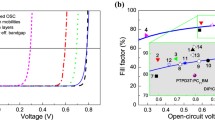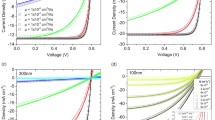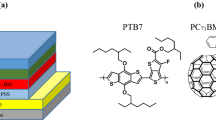Abstract
We present the current-voltage characteristics of organic solar cells based on single and double heterojunction of copper phthalocyanine (CuPc) and C60 by introducing a constant J P instead of photo-current density J ph to represent the density of polaron-pairs generated from excitons at D/A interface. A diode D ext models polaron-pair dissociation, and a diode D rec stands for loss due to polaron-pair recombination. The photovoltaic response under AM 1.5 solar illumination at an intensity of 100 mW/cm2 is parameterized and modeled using the improved equivalent circuit model developed for inorganic pn-junction solar cells. The instinct mechanisms including dissociation, recombination of polaron-pairs and charge carrier collection process are explained by introducing J ph/J P as the dissociation rate of polaron-pairs and |J|/J ph as charge carrier application efficiency ηCA. Especially, we reveal the optimization mechanism for the fill factor FF and series resistance R S of organic solar cells.
Similar content being viewed by others
References
Tang C W. Two-layer organic photovoltaic cell. Appl Phys Lett, 1986, 48: 183–185
Brabec C J, Sariciftci N S, Hummelen J C, et al. Plastic solar cells. Adv Funct Mater, 2001, 11: 15–26
Peumans P, Yakimov A, Forrest S R, et al. Small molecular weight organic thin-film photodetectors and solar cells. J Appl Phys, 2003, 93: 3693–3723
Peumans P, Bulovic V, Forrest S R, et al. Efficient photon harvesting at high optical intensities in ultrathin organic double-heterostructure photovoltaic diodes. Appl Phys Lett, 2007, 88: 2650–2652
Xue J, Uchida S, Rand B P, et al. 4.2% efficient organic photovoltaic cells with low series resistances. Appl Phys Lett, 2004, 84: 3013–3015
Hasobe T, Kashiwagi Y, Absalom M A, et al. Supramolecular phot ovoltaic cells using porphyrin dendrimers and fullerene. Adv Mater, 2004, 16: 975–979
Drechsel J, Männig B, Gebeyehu D, et al. MIP-type organic solar cells incorporating phthalocyanine/fullerene mixed layers and doped wide-gap transport layers. Org Electron, 2004, 5: 175–186
Heutz S, Sullivan P, Sanderson B M, et al. Influence of molecular architecture and intermixing on the photovoltaic, morphological and spectroscopic properties of CuPc-C60 heterojunctions. Sol Energy Mater Sol Cells, 2004, 83: 229–245
Sullivan P, Heutz S, Schultes S M, et al. Influence of codeposition on the performance of CuPc-C60 heterojunction photovoltaic devices. Appl Phys Lett, 2004, 84: 1210–1212
Xue J, Rand B P, Uchida S, et al. A hybird planar-mixed molecular heterojunction photovoltaic cell. Adv Mater, 2005, 17: 66–70
Xue J, Uchida S, Rand B P, et al. Asymmetric tandem organic photovoltaic cells with hybrid planar-mixed molecular heterojunctions. Appl Phys Lett, 2004, 85: 5757–5759
Chan M Y, Lai S L, Fung M K, et al. Doping-induced efficiency enhancement in organic photovoltaic devices. Appl Phys Lett, 2007, 90: 023504
Kim J Y, Lee K, Coates N E, et al. Efficient tandem polymer solar cells fabricated by all-solution processing. Science, 2007, 317: 222–225
Xiao S Q, Li Y L, Li Y J, et al. Fullerene-based molecular triads with expanded Absorptions in the visible region: Synthesis and photovoltaic properties. J Phys Chem B, 2004, 108: 16677–16685
Wemer A G, Li F, Hareda K, et al. Pyronin B as a donor for n-type doping of organic thin films. Appl Phys Lett, 2003, 82: 4495
Hoppe H, Sariciftci N S. Organic solar cells: An overview. J Mater Res, 2004, 19: 1924–1925
Yoo S, Domercq B, Kippelen B. Efficient thin-film organic solar cells based on pentacene-C60 heterojunctions. Appl Phys Lett, 2004, 85: 5427–5429
Nunzi J M. Organic photovoltaic materials and devices. C R Phys, 2002, 3: 523–542
Yoo S, Domercq B, Kippelen B. Intensity-dependent equivalent circuit parameters of organic solar cells based on pentacene and C60. J Appl Phys, 2005, 97: 103706-1–9
Yoo S, Domercq B, Marder S R, et al. Modeling of organic photovoltaic cells with large fill factor and high efficiency. Proc SPIE, 2004, 5520: 110–117
Mazhari B. An improved solar cell circuit model for organic solar cells. Sol Energy Mater Sol Cells, 2006, 90: 1021–1033
Nguyen T P, Rendu P L, Dinh N N. Thermal and chemical treatment of ITO substrates for improvement of OLED performance. Synth Met, 2003, 138s: 229–232
Wu C C, Wu C I, Sturm J C. Surface modification of indium tin oxide by plasma treatment: An effective method to improve the efficiency, brightness, and reliability of organic light emitting devices. Appl Phys Lett, 1997, 70: 1348–1350
Yu J S, Li W Z, Jiang Y D. Bright-yellow organic light-emitting device using novel silole derivative as emitter. Jpn J Appl Phys, 2007, 46: 31–33
Kroon J M, Wienk M M, Verhees W J H, et al. Accurate efficiency determination and stability studies of conjugated polymer/fullerene solar cells. Thin Solid Films, 2002, 223: 403–404
Schilinsky P, Waldauf C, Hauch J, et al. Simulation of light intensity dependent current characteristics of polymer solar cells. J Appl Phys 2004, 95: 2816–2819
Aeronouts T, Greens W, Poortmans J, et al. Extraction of bulk and contact components of the series resistance in organic bulk donor-acceptor heterojunctions, Thin Solid Films, 2002, 403: 297–300
Green M A. Solar cell fill factors: General graph and empirical expressions. Sol State Electron, 1981, 24: 788
Mandoc M M, Veurman W, Koster L J A, et al. Origin of the reduced fill factor and photocurrent in MDMO-PPV:PCNEPV all-polymer solar cells. Adv Funct Mater, 2007, 17: 2167–2173
Arkhipov V I, Heremans P, Bassler H. Why is exciton dissociation so efficient at the interface between a conjugated polymer and an electron acceptor? Appl Phys Lett, 2003, 82: 4605–4607
Morteani A C, Friend R H, Silva C. Endothermic exciplex-exciton energy-transfer in a blue-emitting polymeric heterojunction system. Chem Phys Lett, 2004, 391:81–84
Morteani A C, Sreearunothai P, Herz L M, et al. Exciton regeneration at polymeric semiconductor heterojunctions. Phys Rev Lett, 2004, 92: 247402
Morteani A C, Friend R H, Silva C, et al. Exciton trapping at heterojunctions in polymer blends. J Chem Phys, 2005, 122: 244906
Mihailetchi V D, Koster L A A, Blom P W M, et al. Compositional dependence of the performance of poly(p-phenylene vinylene) Methanofullerene bulk-heterojunction solar cells. Adv Funct Mater, 2005, 15: 795–801
Scharber M C, Mühlbacher D, Koppe M, et al. Design rules for donors in bulk-heterojunction solar cells: Towards 10% energy conversion efficiency. Adv Mater, 2006, 18: 789–794
Chen W B, Xiang H F, Xu Z X, et al. Improving efficiency of organic photovoltaic cells with pentacene-doped CuPc layer. Appl Phys Lett, 2007, 91: 191109
Author information
Authors and Affiliations
Corresponding author
About this article
Cite this article
Huang, J., Yu, J., Lin, H. et al. Polaron-pair-dependent equivalent circuit parameters of organic solar cells based on CuPc and C60 . Chin. Sci. Bull. 55, 1317–1324 (2010). https://doi.org/10.1007/s11434-009-0338-5
Received:
Accepted:
Published:
Issue Date:
DOI: https://doi.org/10.1007/s11434-009-0338-5




